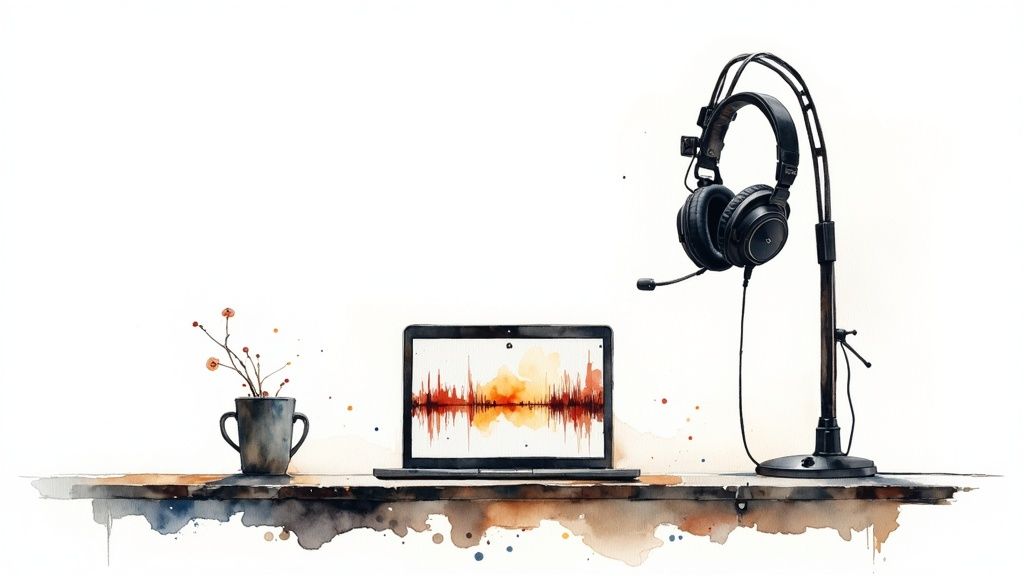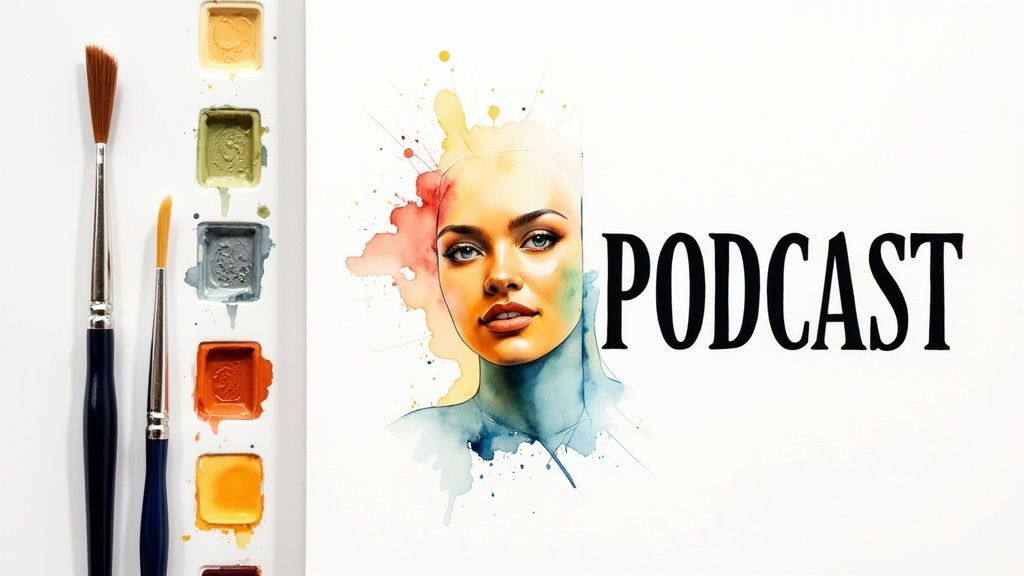The world of podcasting continues to explode, with millions of listeners tuning in for entertainment, education, and connection. For aspiring creators, however, the journey from a spark of an idea to a polished, published episode can feel overwhelming. Where do you even begin? This guide serves as your comprehensive starting a podcast checklist, breaking down the entire process into eight manageable, actionable steps. We move beyond generic advice to provide the specific details, strategic insights, and practical tools needed to launch your podcast and build a foundation for long-term growth.
Just as success in legal matters often relies on comprehensive planning, like following an ultimate deposition preparation checklist, launching your podcast successfully also requires a meticulous step-by-step approach. Following a structured plan is the most reliable way to avoid common pitfalls and ensure a smooth, professional debut.
This article cuts through the noise and delivers a clear roadmap. We will cover everything from defining your niche and format to setting up your recording space, planning initial content, creating your launch strategy, and establishing a sustainable publishing workflow. Whether you're a hobbyist or building a brand, consider this your blueprint for navigating the exciting landscape of audio creation.
1. Define Your Niche and Format
Before you touch a microphone or think about cover art, the most critical first step in our starting a podcast checklist is defining your podcast's core identity. This foundational stage involves two key decisions: carving out a specific niche you are passionate about and selecting a format that best serves your topic and target audience. This isn't just about picking a broad category; it's about creating a unique space within the crowded audio landscape.

A well-defined concept acts as your North Star, guiding every subsequent step from content planning to marketing. For instance, instead of a general 'business' podcast, you might focus on 'SaaS growth strategies for bootstrapped founders'. This specificity attracts a dedicated, high-value listener base from day one.
How to Define Your Podcast's Identity
Start by intersecting your passion, expertise, and a market gap. A niche you are genuinely knowledgeable about ensures content sustainability and authenticity.
Next, choose a format that complements your niche and your strengths. * Solo/Monologue: You are the single host, offering expertise or commentary. * Interview: Features a different guest each episode, like The Tim Ferriss Show. * Co-hosted: Two or more hosts discuss topics, creating a dynamic conversation. * Narrative Storytelling: A highly produced, scripted format, popularized by shows like Serial. * Panel/Roundtable: Multiple guests or experts discuss a single topic.
Actionable Tips for Implementation
- Competitor Analysis: Listen to podcasts in your desired area. Identify what they do well and, more importantly, what they are missing. Is there an underserved audience or a unique angle you can take?
- Test Your Format: Record one or two pilot episodes using different formats. A co-hosted show might sound great in theory, but you may find a solo format feels more natural and sustainable for your schedule.
- Validate Your Idea: Don't create in a vacuum. Survey your existing audience, professional network, or relevant online communities to see if there's genuine interest in your proposed niche and angle.
2. Set Up Recording Equipment and Software
With your concept defined, the next crucial step in your starting a podcast checklist is acquiring the technical tools to capture your voice. Great content can be undone by poor audio quality, so setting up the right equipment and software is non-negotiable for creating a professional and enjoyable listening experience. This involves selecting microphones, an audio interface, and editing software that align with your budget and technical comfort level.

You don't need a professional studio to sound like an expert. Modern equipment, even at the entry-level, can produce incredible sound. The goal is clarity and consistency, ensuring your message is heard without distracting background noise, echoes, or distortion. Podcasting experts like Pat Flynn have long advocated that accessible gear is more than enough to get started.
How to Choose Your Podcasting Gear
Your primary decision is between a USB microphone, which plugs directly into your computer, and an XLR microphone, which requires an audio interface. USB mics are simpler and more budget-friendly, while XLR setups offer more control and higher quality potential.
Select your gear based on your format and budget. * Budget-Friendly (USB): The Audio-Technica ATR2100x-USB is a versatile starting point, offering both USB and XLR connections. * Dedicated Podcast Mic (XLR): The Rode PodMic is specifically designed to capture rich vocal tones for podcasting. * Professional Standard (XLR): The Shure SM7B is the gold standard used by top podcasters like Joe Rogan for its superior sound isolation and quality. * Recording Software: Start with a free, powerful tool like Audacity for recording and editing, or consider Descript for its intuitive, transcript-based editing.
Actionable Tips for Implementation
- Start Simple: If you're on a tight budget, a quality USB microphone is the single most important investment. You can always upgrade your setup later.
- Create a Quiet Space: Record in a room with soft furnishings like carpets, curtains, or blankets to absorb sound and reduce echo. A walk-in closet is a popular DIY recording booth.
- Test Your Levels: Before every single recording session, do a soundcheck. Speak at your normal volume and ensure your audio input levels are not "peaking" into the red, which causes distortion.
- Monitor Your Audio: Always wear headphones while recording. This allows you to hear exactly what the microphone is capturing in real-time, helping you catch issues like plosives (harsh 'p' and 'b' sounds) or background noise.
3. Create Compelling Podcast Artwork and Branding
Your podcast's cover art is its digital storefront, often the first impression a potential listener has before they hear a single second of your audio. In a crowded podcast directory, compelling artwork and consistent branding are not just aesthetic choices; they are crucial marketing tools. This step in our starting a podcast checklist focuses on creating a visual identity that is memorable, professional, and communicates the essence of your show at a glance.

Strong branding helps your podcast stand out and builds instant recognition. Think of iconic shows like This American Life with its distinctive illustration style or Serial's clean, newspaper-inspired design. These visuals are instantly recognizable and perfectly align with the content, a principle emphasized by personal branding experts like Amy Porterfield and Gary Vaynerchuk.
How to Develop Your Podcast's Visual Identity
Your branding should reflect your niche and resonate with your target audience. The goal is to create a cohesive visual language that extends from your main cover art to your episode thumbnails and social media graphics.
Key elements of your visual brand include: * Cover Art: The primary image representing your show on all platforms. * Logo: A simplified version of your brand, usable in various contexts. * Color Palette: A set of 2-3 primary colors that define your visual look. * Typography: Consistent fonts for your podcast title and other text.
Actionable Tips for Implementation
- Prioritize Readability: Your podcast name must be clear and legible even on a small phone screen. Use bold, contrasting colors and a large font. A cluttered design with tiny text will be ignored.
- Test at Multiple Sizes: Before finalizing, view your artwork as a 3000x3000 pixel image and then shrink it down to 55x55 pixels. Ensure it remains visually appealing and recognizable at all sizes.
- Analyze Your Category: Browse the podcast charts in your category. Notice what colors, styles, and imagery are common. Aim to create something that feels appropriate for the genre but is distinct enough to capture attention.
4. Plan Your First 5-10 Episodes
With your niche defined and equipment ready, a crucial next step in any comprehensive "starting a podcast checklist" is to move from abstract ideas to concrete content. This involves planning out your first 5 to 10 episodes in detail. Creating this initial content buffer ensures you launch with momentum and can maintain a consistent publishing schedule, a key factor in building listener trust and habit.

This planning phase isn't about being rigid; it's about building a strong foundation. For example, Pat Flynn of Smart Passive Income often plans episodes strategically, sequencing them to guide his audience through a learning journey. This proactive approach prevents the week-to-week scramble for ideas and allows for higher-quality, more thoughtful content.
How to Build Your Initial Content Pipeline
Start by brainstorming a long list of potential topics that fit within your niche. From there, select the most compelling 5 to 10 ideas to develop first. Think of these initial episodes as your show's pilot season, designed to showcase the value you offer and hook your ideal listener.
For each episode idea, create a detailed outline or script. * Introduction: Hook the listener and state the episode's value proposition. * Main Segments: Break down the core content into 3-5 key talking points. * Call to Action (CTA): What do you want the listener to do next? (e.g., subscribe, visit your website). * Outro: A consistent sign-off that reinforces your brand.
Actionable Tips for Implementation
- Create Episode Templates: Develop a reusable template for your chosen format (interview, solo, etc.). This streamlines your workflow and ensures structural consistency from episode to episode.
- Vary Your Content: Plan a mix of episode types within your first batch. You could include a foundational "pillar" episode, a timely interview, a case study, and a Q&A session to showcase your range.
- Research and Prep: For each planned episode, conduct thorough research. If you're interviewing guests, prepare well-researched questions. For solo shows, gather your data and talking points well in advance to ensure a smooth, authoritative delivery.
5. Choose Podcast Hosting Platform and Distribution
Once your first episodes are recorded and edited, the next critical step in this starting a podcast checklist is getting your show out into the world. This requires a specialized podcast hosting platform. This service stores your large audio files and generates the RSS feed that directories like Apple Podcasts and Spotify use to find and display your show. It's the essential technical backbone that makes your podcast accessible to listeners everywhere.
Choosing the right host is not just about file storage; it impacts your show's reliability, growth potential, and your ability to understand your audience. A good host simplifies distribution, provides crucial analytics, and ensures your episodes are delivered quickly and consistently to your listeners' devices. This is a foundational choice that supports your podcast's long-term success.
How to Select Your Podcast Host
Your hosting platform acts as the bridge between you and your audience. When selecting one, you're investing in the infrastructure that will power your podcast's reach and analytics.
Consider these leading options based on different needs: * Buzzsprout: Known for its incredibly user-friendly interface and outstanding customer support, making it perfect for beginners. * Transistor: A professional-grade host ideal for businesses and networks, offering robust analytics and features for managing multiple shows. * Libsyn: One of the oldest and most established hosts, trusted by many of the world's largest podcasts for its reliability and scale. * Anchor (by Spotify): A completely free option that offers unlimited hosting and seamless integration with Spotify's ecosystem, though with less advanced features.
Actionable Tips for Implementation
- Compare Analytics: Don't just look at download numbers. The best hosts offer IAB Certified analytics, providing data on listener location, playback devices, and popular episodes. This insight is vital for content strategy and attracting sponsors.
- Check Distribution Networks: Ensure the host submits your show to all major directories automatically, including Apple Podcasts, Spotify, Google Podcasts, and Amazon Music. This maximizes your visibility from day one.
- Assess Scalability: Review the pricing tiers and storage limits. A platform that grows with you is essential. Can it handle increased download traffic and a growing back-catalog without forcing a difficult migration later on?
6. Develop Your Podcast Voice and Presentation Style
With your concept and gear sorted, the next crucial item in our starting a podcast checklist is developing your unique on-air persona. This involves cultivating a distinctive speaking style, personality, and presentation approach that engages listeners and makes your show memorable. Your voice is your brand, and how you deliver your content is just as important as the content itself.
This step is about more than just having a "good voice." It's about finding an authentic delivery that connects with your audience and fits your show's format. Think of Ira Glass's distinctive storytelling cadence on This American Life or Marc Maron's raw, conversational style on WTF. These hosts have developed a signature presentation that listeners recognize and return for.
How to Cultivate Your Hosting Style
Your goal is to sound natural, confident, and engaging. This doesn't mean you need to be an energetic, over-the-top personality. Authenticity is key. If you're naturally curious and laid-back, lean into a style like Joe Rogan's. If you're empathetic and a skilled listener, aim for an Oprah-like engaging technique.
Start by considering your show's tone and your natural personality. * Introspective & Conversational: Ideal for deep-dive interviews. * Authoritative & Clear: Works well for solo, educational formats. * Energetic & Witty: A great fit for co-hosted entertainment or comedy shows. * Calm & Measured: Perfect for narrative storytelling or wellness podcasts.
Actionable Tips for Implementation
- Record and Review: Record yourself speaking, either by reading a script or just talking about a topic. Listen back to identify filler words (um, uh, like), pacing issues, and your overall tone.
- Practice Pacing: Many new podcasters speak too quickly due to nerves. Practice speaking at a slightly slower, more deliberate pace than you would in a normal conversation to ensure clarity.
- Study the Greats: Listen actively to hosts you admire, such as Terry Gross on Fresh Air. Don't copy them, but analyze their techniques. How do they ask questions? How do they transition between topics?
- Develop Natural Transitions: Plan how you will move from one segment to the next. Scripting out transitions can help you avoid awkward pauses and maintain the flow of the episode.
7. Create Launch Strategy and Marketing Plan
A great podcast with no listeners is just a well-produced monologue. That's why developing a comprehensive launch strategy and ongoing marketing plan is a non-negotiable step in our starting a podcast checklist. This isn't about simply hitting 'publish' and hoping for the best; it's a calculated effort to build momentum, attract your first wave of loyal listeners, and set the stage for sustained growth.
A powerful launch strategy ensures your podcast makes a significant impact from day one, maximizing your chances of being featured in podcast directories and capturing initial audience excitement. Think of it as the grand opening for your audio brand. Shows like Conan O'Brien Needs a Friend leveraged an existing celebrity platform for a massive launch, while indie hits like Crime Junkie grew through consistent, strategic social media engagement from the very beginning.
How to Develop Your Podcast's Marketing Plan
Your marketing should start long before your first episode goes live. The goal is to build an audience that is eagerly awaiting your debut. This involves creating pre-launch buzz and having a clear post-launch promotional calendar.
Focus on a multi-channel approach that plays to your strengths. * Pre-Launch Hype: Build an email list and create teaser content like audiograms or behind-the-scenes clips for social media. * Launch Day Blitz: Release multiple episodes at once to encourage binge-listening and boost initial download numbers. * Ongoing Promotion: Consistently engage with your community on social media, reach out to other podcasters for cross-promotion, and pitch yourself as a guest on other relevant shows.
Actionable Tips for Implementation
- Launch with a Batch: Publish 3-5 episodes on launch day. This gives new listeners a substantial amount of content to engage with, increasing their likelihood of subscribing and improving your chart rankings.
- Build a Pre-Launch Email List: Offer a valuable incentive, like a sneak peek or a resource guide related to your first episode, to encourage sign-ups. Your email list is a direct line to your most dedicated fans.
- Create Promotional Assets: Prepare audiograms, quote graphics, and video clips from your initial episodes. To maximize your podcast's reach, consider implementing smart content repurposing strategies, transforming your audio into blog posts, social media snippets, and more.
- Engage with Your Niche: Actively participate in online communities (like Reddit, Facebook Groups, or LinkedIn) where your target audience congregates. Share your expertise genuinely before you ever mention your podcast.
8. Establish Content Creation and Publishing Workflow
Consistency is the currency of podcasting, and a reliable workflow is how you mint it. This step in our starting a podcast checklist moves beyond the creative and into the operational, focusing on building a systematic process for producing, editing, and publishing episodes. A well-oiled workflow prevents burnout, ensures timely releases, and maintains a high standard of quality for your listeners.
This isn't about being rigid; it's about being reliable. Great podcasts like The Daily or How I Built This don't just happen; they are the product of rigorous, repeatable systems. Establishing your workflow transforms podcasting from a chaotic hobby into a sustainable content engine, which is essential for long-term growth and audience trust.
How to Systemize Your Podcast Production
Your workflow is a production assembly line, with each stage clearly defined. This system should cover everything from initial brainstorming and recording to final publishing and promotion, ensuring no step is missed. It's the behind-the-scenes discipline that powers public consistency.
Break down your process into distinct phases and assign tasks, even if you are a solo creator. * Pre-Production: Research, outlining, guest booking, and scheduling. * Production: Recording the raw audio. * Post-Production: Editing, mixing, adding intro/outro music, and mastering. * Publishing: Uploading to your host, writing show notes, and scheduling the release. * Promotion: Creating social media assets, writing emails, and sharing the episode.
Actionable Tips for Implementation
- Batch Your Tasks: Dedicate specific blocks of time to similar activities. For example, record four episodes in one day, then edit them all the next week. This creates massive efficiency gains.
- Create a Master Checklist: Document every single step for every episode, from file naming conventions to the final "publish" click. This removes guesswork and reduces errors.
- Build a Buffer: Always aim to have one or two fully produced episodes "in the can." This buffer is your safety net against unexpected delays, sickness, or creative blocks, ensuring you never miss a release date.
- Leverage Automation: To truly systemize your workflow and free up valuable time, look for opportunities to automate repetitive tasks in your production process, such as audio editing, transcription, or social media scheduling.
8-Step Podcast Startup Checklist Comparison
| Podcast Production Step | Implementation Complexity (🔄) | Resource Requirements (⚡) | Expected Outcomes (📊) | Ideal Use Cases (💡) | Key Advantages (⭐) |
|---|---|---|---|---|---|
| Choose Your Podcast Niche and Format | Medium 🔄 | Low to Medium ⚡ | Focused audience, clear content strategy 📊 | New podcasters defining content direction | Builds engaged audience, improves discoverability ⭐ |
| Set Up Recording Equipment and Software | High 🔄 | Medium to High ⚡ | Professional audio quality, editing control 📊 | Podcasters aiming for high-quality sound production | Superior sound quality, scalable setup ⭐ |
| Create Compelling Podcast Artwork and Branding | Medium 🔄 | Medium ⚡ | Strong brand recognition and professionalism 📊 | Podcasts needing standout visual identity | Increases click-throughs, builds brand recall ⭐ |
| Plan Your First 5-10 Episodes | Medium 🔄 | Low to Medium ⚡ | Consistent quality and publishing schedule 📊 | Podcasters wanting organized, strategic content plans | Reduces stress, supports scheduling consistency ⭐ |
| Choose Podcast Hosting Platform and Distribution | Low to Medium 🔄 | Low to Medium ⚡ | Reliable distribution and analytics 📊 | Podcasters requiring easy distribution to platforms | Simplifies tech setup, detailed analytics ⭐ |
| Develop Your Podcast Voice and Presentation Style | Medium 🔄 | Low ⚡ | Strong listener connection and engagement 📊 | Podcasters focusing on personality-driven shows | Builds loyalty, differentiates podcast ⭐ |
| Create Launch Strategy and Marketing Plan | High 🔄 | Medium to High ⚡ | Maximized initial audience and sustained growth 📊 | Podcasters launching new shows aiming for impact | Boosts audience growth, builds credibility ⭐ |
| Establish Content Creation and Publishing Workflow | Medium 🔄 | Medium ⚡ | Consistent publishing and quality control 📊 | Established podcasters scaling production | Improves efficiency, reduces stress ⭐ |
Press Record: Your Journey Starts Now
You've officially navigated the ultimate starting a podcast checklist, moving from a simple idea to a fully-formed launch plan. This comprehensive blueprint isn't just a series of tasks to complete; it's a strategic framework designed to set your podcast up for long-term success and growth. By methodically working through each stage, you have built a powerful foundation that many aspiring creators overlook.
Let's quickly revisit the critical pillars you've established. You started by defining your unique space, selecting a niche and format that aligns with your expertise and your target audience's needs. From there, you tackled the technical but crucial steps of setting up your recording equipment and software, ensuring your audio quality meets professional standards from day one. Your compelling artwork and branding will now act as your show's visual handshake, making a memorable first impression across podcast directories.
From Planning to Performance
The real momentum builds with content planning. By outlining your first five to ten episodes, you've created a content buffer that eliminates the pressure of last-minute recording and ensures a consistent, high-quality start. This proactive approach extends to your launch strategy and marketing plan, giving you a clear path to follow when it’s time to introduce your podcast to the world. You aren't just creating content; you are building a brand and an audience simultaneously.
Mastering these concepts transforms your podcast from a hobby into a strategic asset for your business. A well-executed podcast builds authority, fosters a deep connection with your audience, and drives meaningful traffic back to your business.
Key Takeaway: Consistency is your most powerful tool. A polished launch is fantastic, but a consistent publishing schedule that delivers value week after week is what builds a loyal listenership and achieves sustainable growth.
Your Actionable Next Steps
The journey from here is about execution and evolution. The most successful podcasts are not static; they adapt and refine over time. Your presentation style will mature, your understanding of your audience will deepen, and your production workflow will become a well-oiled machine.
Your immediate next step is simple yet profound: trust the process you've just mapped out. Schedule your first recording session, commit to your publishing workflow, and start sharing your unique perspective. Each episode you publish is a new data point, an opportunity to learn from listener feedback, and a chance to refine your craft. The checklist is complete. Now, the most important action you can take is to press record and begin the conversation. Your audience is waiting to hear from you.
Ready to turn your podcast listeners into loyal customers? The team at rebelgrowth specializes in creating data-driven marketing funnels that convert your audience into qualified leads and sales. Visit rebelgrowth to see how we can help you build a high-performance growth engine for your brand.
